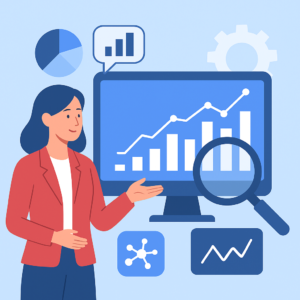For decades, marketing decisions were guided by intuition, experience, and fragmented data. Campaigns were often launched with hope rather than certainty — and visibility into what truly worked remained limited.
Today, that era is ending. Artificial Intelligence (AI) has ushered in a new age of data-driven precision, transforming marketing from an art into a measurable science. AI-powered analytics are helping businesses eliminate guesswork, gain real-time insights, and drive measurable results with greater accuracy than ever before.
At Digital Traffiq, we’ve seen firsthand how AI-driven analytics are reshaping marketing strategies. Businesses embracing these tools are optimizing their campaigns in real time, enhancing ROI, and unlocking a competitive advantage that traditional methods simply can’t match.

What Are AI-Powered Marketing Analytics?
AI-powered marketing analytics combine artificial intelligence, machine learning, and advanced data processing to interpret and act on marketing data.
Unlike traditional analytics that merely report past outcomes, AI systems analyze patterns, predict results, and recommend actions — all in real time. These systems integrate data from multiple sources such as websites, social media, CRMs, and ad platforms to create a unified, comprehensive view of marketing performance.
The real magic lies in continuous learning. As AI models process more data, they refine their predictions and recommendations. Over time, your marketing strategy becomes smarter, more accurate, and more profitable — creating a virtuous cycle of performance improvement.
The Limitations of Traditional Marketing Analytics
Before exploring the benefits of AI, it’s worth noting why traditional analytics often fall short:
Data Silos: Marketing data is scattered across platforms like Google Analytics, Facebook Ads, and CRM tools — making it hard to see the full picture.
Historical Focus: Conventional reports only tell you what already happened, offering little foresight into future trends.
Surface-Level Insights: You might know a campaign got clicks — but not why it worked or how to replicate its success.
Manual Analysis: Extracting actionable insights requires human analysts, which introduces delays, bias, and errors.
These limitations create inefficiency and uncertainty. AI-powered analytics directly solve these challenges by providing a unified, predictive, and automated decision-making system.
Key Benefits of AI-Powered Marketing Analytics
1. Real-Time Performance Insights
AI tools monitor campaign performance as it happens.
If an ad starts underperforming, AI systems can instantly flag it — allowing marketers to adjust before wasting budget. Similarly, when an audience or keyword outperforms, the system can recommend reallocating spend to maximize results.
This level of agility simply isn’t possible with traditional analytics.
2. Predictive Marketing Analytics
Predictive analytics use AI to forecast future trends based on historical data. Some of its most valuable applications include:
Customer Lifetime Value Prediction: Identify high-value customers and focus retention strategies accordingly.
Churn Prediction: Detect disengaged users early and launch proactive re-engagement campaigns.
Campaign Forecasting: Estimate potential performance before full deployment.
Demand Forecasting: Predict shifts in consumer demand to optimize inventory and promotions.
These forecasts empower marketers to plan smarter and act faster.
3. Advanced Attribution Modeling
Traditional “last-click” attribution gives full credit to the final touchpoint before conversion — ignoring earlier influences.
AI-driven attribution, on the other hand, uses complex algorithms to analyze the entire customer journey.
It assigns fair credit to each touchpoint, revealing which channels truly drive conversions and where to allocate budgets most effectively.
4. Automated Campaign Optimization
AI doesn’t just analyze data — it acts on it.
With automated optimization, campaigns are continuously adjusted based on performance signals. Examples include:
Bid Management: Automatically changing bids to maximize ROI.
Audience Targeting: Finding new high-value segments similar to your best customers.
Content Personalization: Customizing creatives or messages for different audience types.
Send-Time Optimization: Delivering emails or push notifications at each user’s ideal engagement time.
This continuous fine-tuning ensures campaigns evolve dynamically with audience behavior.
5. Enhanced ROI Measurement
AI-powered systems integrate marketing data with sales and revenue information, allowing true ROI attribution.
Instead of measuring superficial metrics like clicks or impressions, businesses can now tie every marketing dollar directly to revenue.
This transparency transforms marketing from a perceived cost into a proven revenue driver, strengthening executive confidence and justifying higher budgets.
Implementing AI-Powered Analytics: A Strategic Approach
Transitioning to AI analytics isn’t about buying new software — it’s about building the right data and strategy foundation. Follow these key steps:
Define Clear Objectives: Decide what you want to achieve — improved conversions, lower acquisition costs, or higher lifetime value.
Ensure Data Quality: Audit and clean your data sources before implementation.
Select the Right Platform: Choose tools that integrate seamlessly with your existing marketing stack.
Develop Internal Expertise: Train your team to interpret and act on AI insights.
Start Small and Scale: Begin with a pilot project, learn from it, and expand gradually.
The Future of AI in Marketing Analytics
The next evolution of AI analytics is already unfolding. Expect to see:
Generative AI for Insight Explanation: Systems that explain insights in plain language for non-technical teams.
Cross-Channel Orchestration: Unified coordination across all marketing channels for seamless experiences.
Emotion and Sentiment Analysis: Deeper understanding of customer sentiment and brand perception.
Autonomous Campaign Management: Increasing automation of repetitive tasks, freeing marketers to focus on strategy and creativity.
Conclusion: Embracing the Data-Driven Future
The shift from intuition-based marketing to data-driven intelligence marks one of the most transformative changes in modern business.
AI-powered analytics empower marketers to make smarter, faster, and more confident decisions — transforming uncertainty into opportunity.
At Digital Traffiq, we’ve seen organizations that adopt AI-driven strategies achieve substantial improvements in performance, efficiency, and ROI.
The message is clear:
The age of marketing guesswork is over — and the future belongs to those who embrace AI-powered precision.
Would you like me to add a meta title, meta description, and SEO keywords for this blog (optimized for search engines and LinkedIn preview)? It’ll make it ready for immediate web publication.
